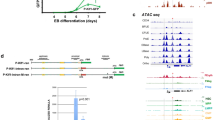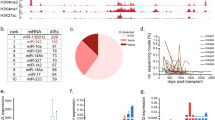Abstract
Human NK cells express cell surface class I MHC receptors (killer cell immunoglobulin-like receptor, KIR) in a probabilistic manner. Previous studies have shown that a distal promoter acts in conjunction with a proximal bidirectional promoter to control the selective activation of KIR genes. We report here the presence of an intron 2 promoter in several KIR genes that produce a spliced antisense transcript. This long noncoding RNA (lncRNA) transcript contains antisense sequence complementary to KIR-coding exons 1 and 2 as well as the proximal promoter region of the KIR genes. The antisense promoter contains myeloid zinc finger 1 (MZF-1)-binding sites, a transcription factor found in hematopoietic progenitors and myeloid precursors. The KIR antisense lncRNA was detected only in progenitor cells or pluripotent cell lines, suggesting a function that is specific for stem cells. Overexpression of MZF-1 in developing NK cells led to decreased KIR expression, consistent with a role for the KIR antisense lncRNA in silencing KIR gene expression early in development.
This is a preview of subscription content, access via your institution
Access options
Subscribe to this journal
Receive 6 digital issues and online access to articles
$119.00 per year
only $19.83 per issue
Buy this article
- Purchase on Springer Link
- Instant access to full article PDF
Prices may be subject to local taxes which are calculated during checkout




Similar content being viewed by others
References
Trinchieri G . Biology of natural killer cells. Adv Immunol 1989; 47: 187–376.
Lanier LL . NK cell recognition. Annu Rev Immunol 2005; 23: 225–274.
Carrington M, Norman P . The KIR Gene Cluster. National Library of Medicine (US), NCBI: Bethesda, MD, USA, 2001.
Anderson SK, Ortaldo JR, McVicar DW . The ever-expanding Ly49 gene family: repertoire and signaling. Immunol Rev 2001; 181: 79–89.
Parham P . MHC class I molecules and KIRs in human history, health and survival. Nat Rev Immunol 2005; 5: 201–214.
Valiante NM, Uhrberg M, Shilling HG, Lienert-Weidenbach K, Arnett KL, D'Andrea A et al. Functionally and structurally distinct NK cell receptor repertoires in the peripheral blood of two human donors. Immunity 1997; 7: 739–751.
Held W, Kunz B . An allele-specific, stochastic gene expression process controls the expression of multiple Ly49 family genes and generates a diverse, MHC-specific NK cell receptor repertoire. Eur J Immunol 1998; 28: 2407–2416.
Santourlidis S, Trompeter HI, Weinhold S, Eisermann B, Meyer KL, Wernet P et al. Crucial role of DNA methylation in determination of clonally distributed killer cell Ig-like receptor expression patterns in NK cells. J Immunol 2002; 169: 4253–4261.
Chan HW, Kurago ZB, Stewart CA, Wilson MJ, Martin MP, Mace BE et al. DNA methylation maintains allele-specific KIR gene expression in human natural killer cells. J Exp Med 2003; 197: 245–255.
Björkström NK, Riese P, Heuts F, Andersson S, Fauriat C, Ivarsson MA et al. Expression patterns of NKG2A, KIR, and CD57 define a process of CD56dim NK-cell differentiation uncoupled from NK-cell education. Blood 2010; 116: 3853–3864.
Saleh A, Davies GE, Pascal V, Wright PW, Hodge DL, Cho EH et al. Identification of probabilistic transcriptional switches in the Ly49 gene cluster: a eukaryotic mechanism for selective gene activation. Immunity 2004; 21: 55–66.
Davies GE, Locke SM, Wright PW, Li H, Hanson RJ, Miller JS et al. Identification of bidirectional promoters in the human KIR genes. Genes Immun 2007; 8: 245–253.
Li H, Pascal V, Martin MP, Carrington M, Anderson SK . Genetic control of variegated KIR gene expression: polymorphisms of the bi-directional KIR3DL1 promoter are associated with distinct frequencies of gene expression. PLoS Genet 2008; 4: e1000254.
Tanamachi DM, Moniot DC, Cado D, Liu SD, Hsia JK, Raulet DH . Genomic Ly49A transgenes: basis of variegated Ly49A gene expression and identification of a critical regulatory element. J Immunol 2004; 172: 1074–1082.
Stulberg MJ, Wright PW, Dang H, Hanson RJ, Miller JS, Anderson SK . Identification of distal KIR promoters and transcripts. Genes Immun 2007; 8: 124–130.
Cichocki F, Hanson RJ, Lenvik T, Pitt M, McCullar V, Li H et al. The transcription factor c-Myc enhances KIR gene transcription through direct binding to an upstream distal promoter element. Blood 2009; 113: 3245–3253.
Cichocki F, Miller JS, Anderson SK . Killer immunoglobulin-like receptor transcriptional regulation: a fascinating dance of multiple promoters. J Innate Immun 2011; 3: 242–248.
Cichocki F, Lenvik T, Sharma N, Yun G, Anderson SK, Miller JS . Cutting edge: KIR antisense transcripts are processed into a 28-base PIWI-like RNA in human NK cells. J Immunol 2010; 185: 2009–2012.
Bamezai S, Rawat VPS, Buske C . Concise review: the Piwi-piRNA axis: pivotal beyond transposon silencing. Stem Cells 2012; 30: 2603–2611.
Hromas R, Davis B, Rauscher FJ 3rd, Klemsz M, Tenen D, Hoffman S et al. Hematopoietic transcriptional regulation by the myeloid zinc finger gene, MZF-1. Curr Top Microbiol Immunol 1996; 211: 159–164.
Morris JF, Hromas R, Rauscher FJ 3rd . Characterization of the DNA-binding properties of the myeloid zinc finger protein MZF1: two independent DNA-binding domains recognize two DNA consensus sequences with a common G-rich core. Mol Cell Biol 1994; 14: 1786–1795.
Morris JF, Rauscher FJ 3rd, Davis B, Klemsz M, Xu D, Tenen D et al. The myeloid zinc finger gene, MZF-1, regulates the CD34 promoter in vitro. Blood 1995; 86: 3640–3647.
Chan HW, Miller JS, Moore MB, Lutz CT . Epigenetic control of highly homologous killer immunoglobulin-like receptor gene alleles. J Immunol 2005; 175: 5966–5974.
Djebali S, Davis CA, Merkel A, Dobin A, Lassmann T, Mortazavi A et al. Landscape of transcription in human cells. Nature 2012; 489: 101–108.
Lee JT . Epigenetic regulation by long noncoding RNAs. Science 2012; 338: 1435–1439.
Sigova AA, Mullen AC, Molinie B, Gupta S, Orlando DA, Guenther MG et al. Divergent transcription of long noncoding RNA/mRNA gene pairs in embryonic stem cells. Proc Natl Acad Sci USA 2013; 110: 2876–2881.
Oostendorp RA, Harvey KN, Kusadasi N, de Bruijn MF, Saris C, Ploemacher RE et al. Stromal cell lines from mouse aorta-gonads-mesonephros subregions are potent supporters of hematopoietic stem cell activity. Blood 2002; 99: 1183–1189.
Acknowledgements
This project has been funded in whole or in part with federal funds from the National Cancer Institute (NCI), NIH, under contract HHSN261200800001E and NCI grant P01 111412 (JSM, SKA). This research was supported in part by the Intramural Research Program of the NIH, NCI, Center for Cancer Research.
Disclaimer
The content of this publication does not necessarily reflect the views or policies of the Department of Health and Human Services, nor does mention of trade names, commercial products or organizations imply endorsement by the US Government.
Author information
Authors and Affiliations
Corresponding author
Ethics declarations
Competing interests
The authors declare no conflict of interest.
Rights and permissions
About this article
Cite this article
Wright, P., Huehn, A., Cichocki, F. et al. Identification of a KIR antisense lncRNA expressed by progenitor cells. Genes Immun 14, 427–433 (2013). https://doi.org/10.1038/gene.2013.36
Received:
Revised:
Accepted:
Published:
Issue Date:
DOI: https://doi.org/10.1038/gene.2013.36
Keywords
This article is cited by
-
The KIR2DL1 intermediate upstream element participates in gene activation
Immunogenetics (2023)
-
Probabilistic Bidirectional Promoter Switches: Noncoding RNA Takes Control
Molecular Therapy - Nucleic Acids (2014)



